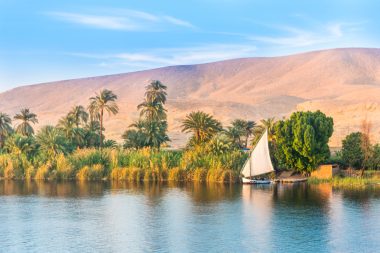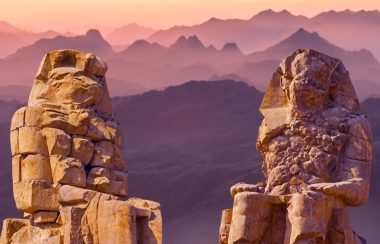“City of Palaces” – that is the current name Luxor, the ancient pharaoh’s city, whose millennia-old history still fascinates visitors today. Located directly on the Nile and about 500 kilometers south of the capital Cairo , Luxor is the largest city in Upper Egypt. Although it has been renamed more than once, it is still known by the Greek name of Thebes. The lifeline of Egypt – the Nile – divides the city into two parts: Thebes-West and Thebes-East.
Luxor is where ancient Egyptian culture and modernity meet, as the city has a progressive centre and an international airport in addition to historical sights. It is often the starting point of Nile cruises.
Some of the most important cultural treasures of all of Egypt are located in Luxor. Visitors can literally go on a journey through time and experience the country’s fascinating past up close.
How far is it from Luxor to the tourist areas of Egypt?
Luxor is centrally located in Egypt and offers relatively good connections to other major tourist destinations in the country. Here are the approximate distances from Luxor to other major tourist areas in Egypt:
- Cairo: About 650 kilometers north of Luxor. The journey by car takes about 8 to 9 hours, while by plane it only takes about an hour.
- Aswan: About 230 kilometers south of Luxor. By car or train, the journey takes about 3 to 4 hours.
- Hurghada: About 290 kilometers east of Luxor. The drive by car along the desert road takes about 4 to 5 hours.
- Sharm El-Sheikh: Located about 480 kilometers east of Luxor, on the other side of the Red Sea. A trip here can be more complicated, as it involves a longer land route and possibly a ferry across the Red Sea or a domestic flight.
- Alexandria: About 800 kilometers northwest of Luxor. The journey by car can take around 10 to 12 hours, although a flight to Cairo followed by another short flight or train ride to Alexandria may be a faster option.
- Abu Simbel: About 280 kilometers south of Aswan or about 510 kilometers from Luxor. There are no direct road connections, so the best option is often a short domestic flight or a combination of road and river travel.
The Treasures of Thebes-West

The district west of the Nile is still referred to today as Thebes West. Since the ancient Egyptians believed that the realm of the dead began in the west, this part of today’s Luxor is mainly dedicated to the dead.
One of the most important historical burial sites in the whole world is not far from the city: the famous Valley of the Kings. Here are gravediggers of Egyptian rulers carved into the rock, including that of the legendary Tutankhamun. The discovery of this tomb caused a worldwide sensation because, compared to the other more than 60 tombs discovered so far in the Valley of the Kings, it was the only one not plundered by tomb robbers. A little further south is also the Valley of the Queens. These legendary cemeteries were part of the new Egyptian empire, where the tombs were built separately from royal temples, unlike the Pyramid Age

Near the Valley of the Kings are the imposing Colossi of Memnon, which were built as guardians of the temple of King Amenhotep III. The twin statues symbolize the seated pharaoh and received their current name during the Greek period. The Colossi of Memnon are almost the only remains of the Temple of Amenhotep III, and the complex itself has been largely destroyed. Originally, they were about 21 meters high, but since the crowns on the heads are no longer present, they now have a height of about 17 and 18 meters respectively.
One of the best-preserved temple complexes in Thebes West is the temple in honor of Queen Hatshepsut. From a distance, it offers a spectacular sight, carved into limestone in several stages and with its colonnades. Inside there are chapels in honour of the queen herself as well as various deities. As with most ancient Egyptian temples, the entrances of the Hatshepsut Temple face the banks of the Nile. From here, a processional route lined with sphinxes used to lead to the Temple of Amun-Re in the temple complex of Karnak on the east side of the Nile.
 Our tip to get in the mood: Download the 206-page illustrated book “Luxor + Thebes” from Medien-Franken.de.
Our tip to get in the mood: Download the 206-page illustrated book “Luxor + Thebes” from Medien-Franken.de.
Tradition and modernity in Eastern Thebes
The modern center of Luxor is located on the east side of the Nile. Nevertheless, two of the most famous ancient temples can also be found here.
Only a few kilometers north of Luxor lies the imposing temple complex of Karnak. It is the largest temple complex in Egypt and consists of three districts: the district of Mut, the district of Montu and the most important district of Amun, which is dedicated to the god Amun-Re. Among other things, it is home to the huge Great Hypostyle Hall with 134 columns that rise to the sky and is one of the most impressive buildings of all time. In addition, there are numerous other fascinating remnants of the former high culture to admire, such as the White and Red Chapels, the temple in honor of Ramses III or the Holy Lake. Another highlight is the daily sound and light show after sunset.
A processional route – of which the famous Sphinx Avenue can still be seen today – connected the Karnak Temple with the Luxor Temple in the middle of the city. It is also dedicated to the god Amun and his wife Mut as well as his son Khons, the so-called triad of gods. In addition to the Avenue of the Sphinx, the two 15-metre-high statues of Ramses II that guard the gate to the first courtyard stand out. One of two obelisks is also still there. The Luxor Temple also has stunning colonnades and halls that can be found further inside. A visit is especially worthwhile at sunset, which then bathes the Sphinx Avenue in a magical light.
Between the two temples Karnak and Luxor, right on the banks of the Nile, lies the Luxor Museum of Ancient Egyptian Art. It houses an exciting collection of finds from ancient Thebes, including some grave goods from the tomb of Tutankhamun from the Valley of the Kings, a statute of King Amenhotep III and a statue of the gods Amun and Mut from the time of Ramses II. The mummies of Kings Ahmose I and Ramses I can also be found here.
Things to do in Luxor
The stay in Luxor is made perfect by various activities that convey typical Egyptian flair. For example, guests can enjoy the sunset on a felucca ride on the Nile. A visit to the local bazaar is also popular, where you can haggle and bargain. Here you will find all kinds of spices, jewellery, carpets or souvenirs.
On a horse-drawn carriage ride, hidden corners of the city can be explored and authentic life can be observed. And of course, as in most desert countries, camel riding is also traditionally offered.
Cultural wonders paired with multifaceted activities make Luxor a very special city in Egypt, whose visit is guaranteed to make unforgettable memories.
Facts about Luxor
- Historical significance: Luxor is often referred to as the “largest open-air museum in the world”. The city is located on the site of ancient Thebes, the powerful capital of Egypt’s New Kingdom.
- Karnak Temple Complex: One of the largest and most important temple complexes in Egypt, the Karnak Temple is located in Luxor. It was dedicated to the god Amun for several centuries and has been constantly expanded.
- Valley of the Kings: The famous Valley of the Kings is located on the west side of the Nile opposite Luxor. It is the burial place of almost all the pharaohs of the New Kingdom, including Tutankhamun, whose tomb was discovered in 1922.
- Luxor Temple: Located in the heart of the modern city, the Luxor Temple is known for its grandiose architecture and the row of sphinx statues that mark the entrance. It was mainly built by Amenhotep III and Ramses II.
- Colossi of Memnon: The impressive statues of Amenhotep III, known as the Colossi of Memnon, stand as guardians over the entrance to his ruined mortuary temple.
- Cultural Heritage: In addition to the grand temples and tombs, Luxor is also home to the Luxor Museum, which exhibits exquisite artifacts from the region, and the Mummification Museum, which provides insight into ancient Egyptian burial practice.
- Tourism: Luxor is one of the most important tourist destinations in Egypt and attracts visitors who want to explore the historical monuments and take a boat trip on the Nile.
- Archaeological Significance: The city and its surroundings continue to be a center of archaeological research and discovery, where new finds are made almost annually, expanding our understanding of Egyptian history.


